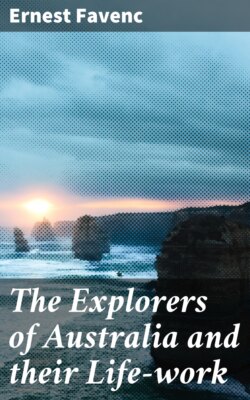Читать книгу The Explorers of Australia and their Life-work - Ernest Favenc - Страница 20
На сайте Литреса книга снята с продажи.
3.4. THE BRISBANE RIVER.
ОглавлениеIt was in October, 1823, that Oxley left Sydney on the expedition that resulted in the finding of the Brisbane River, and the foundation of the settlement at Moreton Bay. He was despatched on a mission to examine certain openings on the east coast, and report on the suitability of them as sites for penal establishments. Moreton Bay, Port Curtis, and Port Bowen were selected; and Oxley left in the colonial cutter Mermaid, with Uniacke and Stirling as assistants.
As the cutter went up the coast, she called at Port Macquarie, and Oxley had the pleasure of noting the rapid growth of the settlement that had been built upon his recommendation. Further along the coast, Oxley discovered and named the Tweed River. The Mermaid reached Port Curtis on the 6th of November, and cast anchor for some time, during which Oxley made a careful examination of the locality, his opinion of it as a site for a settlement being decidedly unfavourable. He however discovered and named the Boyne River.
It being considered too late in the season to proceed and examine Port Bowen, the Mermaid went south again, and entering Moreton Bay, anchored off the river that appeared to Flinders to take its source in the Glass House Peaks, and which he had called the Pumice Stone River.
They had scarcely anchored when several natives were seen at a distance, evidently attracted by their arrival, and on examining them with the telescope, Uniacke was struck with the appearance of one of a much lighter colour than that of his companions. The next day Oxley landed and discovered that the man they had noticed was in reality a castaway white man of the name of Pamphlet. He told a singular tale.
He had left Sydney in an open boat with three others, intending to go to the Five Islands and bring back cedar. A terrible gale arose, and they were blown out to sea and quite out of their reckoning, Pamphlet being under the impression that they had come ashore south of Port Jackson. They had suffered fearful hardships in the open boat, being at one time, he averred, twenty-one days without water, during which time one man died of thirst. The boat was at last cast up on an island in the bay (Moreton Island) where they had joined the blacks, and lived amongst them ever since, a matter of seven months. The other survivors were named Finnegan and Parsons. Pamphlet informed Oxley that not long before the Mermaid arrived, the three of them had started to try and reach Sydney overland, but when they had got about fifty miles, he had turned back and the next day had been rejoined by Finnegan, who stated that he had quarrelled with Parsons. The latter was never heard of again.
Finnegan put in an appearance the next day, and Oxley naturally took the opportunity to question them as to the knowledge they had gained of the surrounding country during their enforced stay in it. On one important point both of them were confident, and this was that, in the southern portion of the bay, a large river was to be found which appeared navigable, having a strong current.
Taking Finnegan with them, Oxley and Stirling started in the whaleboat the following morning to verify this information. They found the river and pulled up it about fifty miles. Oxley was greatly pleased with such a discovery, and landing, ascended a hill which he named Termination Hill. From the top he obtained a view over a wide extent of country, through which he was able to trace the river for a long distance. Strangely enough, the hasty glimpse he thus caught of a new and untrodden part of Australia seemed to confirm his fixed belief in the final destination of the Lachlan and the Macquarie as an inland sea.
"The nature of the country and a consideration of all the circumstances connected with the appearances of the river, justify me in entertaining a strong belief that the source of the river will not be found in mountainous country, but rather that it flows from some lake, which will prove to be the receptacle of those inland streams crossed by me during an expedition of discovery in 1818."
Oxley named the river the Brisbane, and, taking aboard the two rescued men, the Mermaid set sail for Port Jackson, where she arrived on December 13th. This ended the chapter of Oxley's discoveries in the field of active exploration.
